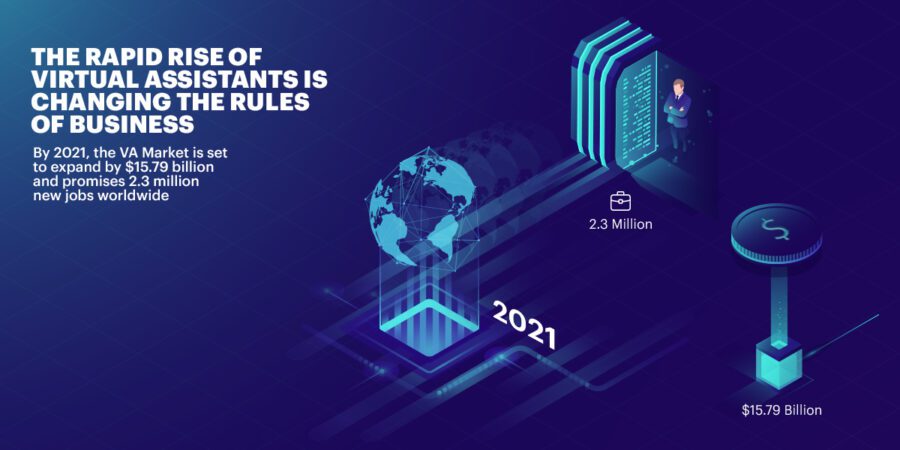In the late 1990s, AI rose to prominence. In 1997, IBM’s Deep Blue supercomputer grabbed headlines for defeating the world chess champion then, Garry Kasparov. We have come a long way; from the computer that beat a chess champion to the advanced virtual assistants like Siri, Google Now, Amazon Echo, and many more that we have today.
These virtual assistants can schedule events to help plan the day better, add reminders before you run out of groceries, book a table at that favourite restaurant for dinner, play music for those jazz moods, and update users with news relevant to them.
Undoubtedly, virtual assistants have become a force to reckon with. A report on GO-Gulf, ‘The Rise of Virtual Digital Assistants Usage’, states that the total number of people who will use digital assistants globally is likely to be $1.8 billion by 2021. It also states that by 2021, the Virtual Digital Assistant (VDA) market will expand by $15.79 billion worldwide.
Growing Business of Virtual Assistants and Chatbots
While the masses engage with virtual assistants to go about their daily tasks, organisations need chatbots to automate tasks. 72% business leaders consider the development of virtual assistants as a business advantage. According to Accenture, “the impact of AI technologies on business is projected to increase labor productivity by up to 40% and enable people to make more efficient use of their time.”
It is increasingly important for companies to familiarise themselves with Chatbots and synchronise operations in line with them. By using simple user interface, these Chatbots perform tasks that were traditionally done by humans. It saves labour, time and money as Chatbots can handle less-urgent customer-facing situations. AI is gradually becoming a vital support to human capabilities. In The Forrester Report, ‘2017 Customer Service Trends: Operations Become Smarter and More Strategic,’ highlights that “…companies will continue to explore the power of intelligent agents to add conversational interfaces to static self-service content.”
Enterprise companies are increasingly using chatbots within recruitment. There is always a need to find qualified talent. Often, hiring managers receive hundreds of resumes per open role. When shortlisting candidates for interviews, they use various data points such as filtering out candidates with too many or too few years of experience. Beyond this level of filtering, many companies like Accenture use Min, an AI virtual recruiter to hire data scientists in Singapore. This helps recruiters save time, improve efficiency, and make fair hiring decisions. For candidates, the chatbot engages, interviews, and shortlists them 24/7.
Virtual assistants and Chatbots play a pivotal role in data science and analytics. They collect data, and through deep learning and predictive analytics, provide insight on consumer behaviour and can predict trends and patterns.
Consumer Dependency on AI
Virtual assistants have also led to an expansion in the job market. Companies using AI will need human help data scientists and AI developers. Hence there is immense scope for jobs in newer categories. According to research firm Gartner, AI is estimated to create 2.3 million new jobs worldwide, eliminating 1.8 million traditional jobs.
Due to the growing demand from the consumers, companies are investing in virtual assistants. Siri and Google Now continue to lead the market of the virtual assistant. Companies are using Chatbots to reach out to their customers. The presence of 34,000 Chatbots on Facebook alone attests to this growing demand.
One of the major reasons for the growing customer-engagement with virtual assistants is because it’s quick and instant. Chatbots are designed to avoid arguments with customers, respond instantly, and create a better customer experience. According to a recent Zendesk study, 42% of B2C customers purchased more after a good customer service experience.
How Chatbots are Enhancing Customer Engagement?
Chatbots enhance the customer experience by rendering a sense of conversation. Effective and experiential communication calls for intuitive solutions. Hence, Chatbots are integrated with NLP (Natural Language Processing) to understand customers in real time and start a dialogue with them in their language.
Through NLP, a Chatbot can process the intent behind what the customer has said. It provides an understanding of what the customers are saying, be it through conversations, or social media interactions. This helps to track customers’ preferences, buying behaviour, sentiments and feelings.
Also, many Chatbots are built with pre-trained RNN (Recurrent Neural Network) to deal with off-topic questions. To put it simply, a Chatbot answers to all the queries of customers. At times, these bots are posed with some off-topic questions that don’t fall under the purview of the Chatbot’s information. In such cases, RNN is used so that the Chatbot can generate a relevant answer.
The Road Ahead
There are quite a few challenges that will come with the exploration of AI. For example, automating jobs that require more technical expertise will take years to develop. AI has to move ahead from simply automating tasks performed by human processes to redefining the entire business model.
Paul Jarrett, managing director of London-based mobile app developer Sonin App Development, tells GearBrain that there’s a lot to be done in terms of actual intelligence. He says, “Today, AI assistants are primarily an additional route to information gathering and can complete simple tasks within set criteria. In order to become truly intelligent, they need to fully understand the user and user intuition.”
We live in an age where ‘Google Search’ has made our lives convenient. Information access has become efficient and quick. In such an environment, it is inevitable that the demand for virtual assistants is only going to grow. Humans are constantly looking for a faster and better lifestyle and virtual assistants are helping us to achieve so. Thus the future of virtual assistants is promising. Although we have miles to go, surely the growth of AI and virtual assistants is not going to slow down any time soon!
References
https://www.gearbrain.com/alex-siri-ai-virtual-assistant-2510997337.html
https://insuranceblog.accenture.com/making-the-best-use-of-ai-capabilities\
https://medium.com/swlh/chatbots-of-the-future-86b5bf762bb4
https://www.ibm.com/blogs/watson/2017/10/10-reasons-ai-powered-automated-customer-service-future/
https://www.cardfellow.com/blog/chatbots-for-business/
https://www.marutitech.com/benefits-chatbot/
https://www.accenture.com/bg-en/artificial-intelligence-index
https://hbr.org/cover-story/2017/07/the-business-of-artificial-intelligence
https://www.cognizant.com/artificial-intelligence##
https://www.capgemini.com/2018/02/how-artificial-intelligence-is-changing-how-we-do-business/
https://www.iqvis.com/blog/best-artificial-intelligence-tools-for-businesses/
http://www.information-age.com/rise-artificial-intelligence-123471102/

